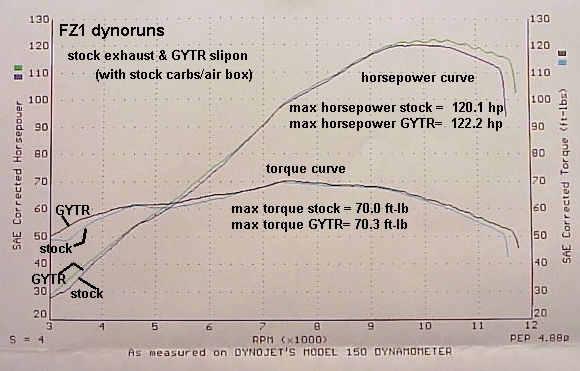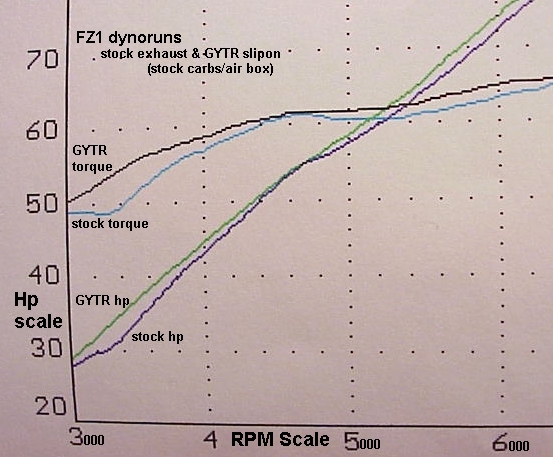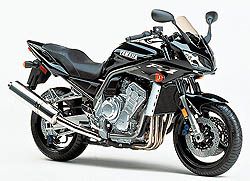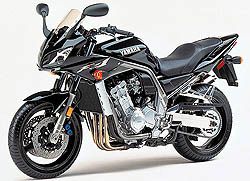|
FZ1, Super Standard
....Before
considering the GYR-R Slip-on for your FZ1, you might drop down to the bottom of
this page and review some of my observations and opinions.
|
[] IowaZ Sitemap [] Send Email [] FZ1 Owner's Association [] IowaZ Vmax Sitemap [] IowaZ V65 Magna Page []
Use the FZ1 Sitemap to navigate all of the FZ pages.
Yamaha FZ1
the installation of Yamaha's
FZ1 GYT-R Carbon Slip-on
FZ1 GYT-R Slip-on (GYT-R means
Genuine Yamaha Technology and Racing)
....Yamaha states: It should not
be necessary to change the jetting of the FZ1 after bolting on the GYT-R
exhaust system, however, this is dependent on weather and altitude of the
riding location.
....Yamaha
says: After
3 years experience in performance exhaust system development, Yamaha Parts
& Accessories Division came up with our next generation round systems.
These pipes use even more lightweight materials than before to rival the best
race systems on the market. Special high-volume design helps improve exhaust
flow performance. Slip-On Exhaust installs easily without removal of the stock
header or EXUP Valve, and adds 4.5 horsepower in the midrange, plus 1 or more
peak horsepower. All GYT-R Slip-on exhausts install easily. For
closed-course competition only.
....Carbon Saves 7 pounds compared to the OE system; adds 4.5 HP throughout
the mid-range and 1 peak HP. Aluminum
Saves 5-3/4 pounds compared to the OE system; adds 4.5 HP throughout the
mid-range and 1 peak HP.
....The stock exhaust weighed 11lb 2oz, while the
GYTR slip-on and parts weighted about 4lb 2 oz. The seven pound loss of
weight will slightly improve handling and will add about one net horsepower on
the road.
Stock Exhaust Removal
....Remove of the stock exhaust
and pipe by following the removal page on this
site (use the Sitemap to navigate) or
....Loosen the OE clamp at the junction where the OE silencer meets the
collector.
....Remove mounting hardware from rear footpeg/silencer mount and place aside
as it will be used during installation of the GYT-R exhaust system.
....Slide the OE silencer off the collector. Store the OEM system in case it is to be
used at a later time.
Rear view of the GYT-R system installed.
Installation of the GYT-R Slip-on
Close-up rear view of the GYT-R Slip-on installed and the tools used.
....Place the bike on centerstand.
....Tools: 3/8" socket drive and medium extender, 8mm hex
socket, 11 mm deep-well six-point socket, 14 mm open ended wrench.
....Insert the muffler gasket into the
inlet pipe that slips onto the collector. You can observe the old gasket
in the stock pipe if not sure of its position.
With the collector pipe inserted into the exhaust
pipe of the new slip-on, you can see the clamp in final position, plus the
leading edge of the gasket is visible just barely sticking out of the pipe and
in the pic above just to the right of the clamp edge.
....Slide the Inlet Pipe Clamp onto the inlet pipe of the GYT-R muffler.
....The clamp should be very near
the end of the pipe when tightened down during the final steps.
....The clamp nut is pointed to the outside in the view below, but should be
rotated to a nearly down position so it is up and under the bike when finally
tightened down.
....Install the rubber insulator strip onto the Stainless Steel mounting strap.
....Slip the inlet pipe of the GYT-R slip-on onto the collector coming from the engine headers.
....Slide the muffler strap and insulator assembly over the end of the muffler body so that the mounting tabs of the strap are between the centerline of the muffler and the motorcycle. Note: Be careful to get the strap/clamp on the correct way or it may be hit by the swing arm during normal operation of the suspension.
....Squeeze the strap together and line up the mounting slots with the inside surface of the rear footpeg/silencer mount, as shown in the pic below.
....Insert the stock bolt through
the footpeg/silencer mount, strap mounting slot and apply the nut, and hand
tighten. Adjust as necessary so that the strap is perpendicular to
muffler body. Torque to 30 Nm or 22 ft-lb.
....A 14mm wrench will be needed to hold the nut to the back of the hex bolt.
....After tightening the muffler strap down, check to see if the muffler turns in the clamp because the rubber insulator strap is too thin to hold it in place. Many FZ1 GYTR owners have complained about the muffler spinning on the pipe and not being able to secure the muffler can with the clamp/strap.
....Finally, rotate the pipe clamp so the keeper nut is up under the bike but still able to be reached with a socket and socket drive. Tighten the inlet pipe clamp securely.
....The pipe clamp nut is pointed out in the pic above, be sure to rotate it up and under the bike to keep the nut out of the way and out of view, as shown in the pic below. Note that the rubber bumper contacts the pipe to the inside of center and on the outer edge of the bumper.
....Start the bike and check for
gas leaks around the pipe/collector area, and especially around the junction
of the muffler can with the pipe. You might use some alcohol on a
rag and try to wipe off any oils from your hands, etc from the stainless steel
pipe and other metals, as sometimes there can be different colorations as the
pipe gets hot, especially the first few times.
....One way to check the system for leaks it to hold cloth pad in your hand
and cover up the exhaust opening and the blip the throttle. If the
system is "tight" your hand will literally be blown off the exhaust.
Initial observations and opinions
regarding the GYT-R Slip-on----
....My initial opinion of the system upon opening the box
was the workmanship was fine. All parts had been shipped including a new
gasket for the connection between the pipe and collector, and a nut for
mounting the rear muffler strap.
....After closer examination it could be observed the logo plate on the Can
had been riveted on with poor craftsmanship as the back end was bowed up with
a 1/16" space under it.
....Another concern was the fact the Can was free to spin on the pipe, and
actually quite loose.
....No major mounting problems occurred. The slip-on should go on for
anyone without a hitch. That is unless the rubber insulator that is
placed inside the mounting strap that goes around the Can is not tight enough
to hold the Can in place. If the strap is not right the can will
"spin" constantly. I was quite concerned during the tightening
of the strap that it would not become tight enough to hold the Can, however so
far the Can is tight in the strap and does not spin. Others have
reported that the Can is not held secure and spins in the strap. I
suppose one could find another strip of rubber and try to increase the
thickness slightly. It cannot be too thick as one does not want
excessive pressure on the Can, especially if it is carbon fiber.
....Using a cloth pad over the opening to test for leaks, I found mine system
was perfectly sealed. I was concerned initially because of the free
spinning Can. The Hindle system on my Vmax came in two sections like
many of the racing system, so the Can could be somewhat pressed onto the pipe
and then a spring holds the Can to the pipe. In the case of the GYT-R
Slip-on the clamps holds the Can and pipe in position.
....The biggest concern at this time is the fact the GYT-R Slip-on does not
have a stop for the rubber bumper-pad on the centerstand. The stock
system had a tab welded on the pipe so the centerstand rubber bumper rested
squarely upon the tag. On my system the outside edge of the rubber
bumper hits the pipe in the middle, thus there has to be some torsional force
on both the pipe and centerstand. It may not be enough to create any
concerns. One good thing seems to be the fact the rubber bumper does not
melt. Geo (Z-Guy) as of the end of August 2001 has run his GYT-R system
over 8k miles (He has put 15+k miles on his FZ in about half a year!! One of
my major hero's :).
....Posted Oct 2001 by ZGuy---Morning all: I figured I'd provide a
running update on this pipe since I'm having a little problem with it. I've
been hearing some weird high-pitched buzzing lately, couldn't figure out what
it was until I was washing the bike yesterday. The rivets holding the exhaust
end of the can are really loose. I checked the fronts, they are getting there
real fast as well. Looks like I'll have to do a re-rivet job this winter
unless I get crazy enough to buy that full yosh system, I keep hearing its
name in my sleep, heehee..I am a little worried about the noise though, thats
the only thing holding me back at the moment. In all fairness, I have about
14-15,000 miles on the yammie pipe.
....And a response---yea, My GYTR pipe is loose and buzzing like a mother.
Time to write a letter to Yamaha. WARNING-Dont by this junk.
Pics of the Areas of Concern on the Yamaha GYT-R Slip-on.
....The junction between the Can and exhaust pipe is an area of concern for
some, but although the Can on my system freely spins at this junction there
are presently no leaks and the seal is perfect. Some report that this
area will move laterally thus there has to be a gap that leaks gases.
The junction is very tight and sealed on my system. There is no lateral
movement.
....Since the Can freely spins on the exhaust
pipe, if the Can clamp is not capable of pinching the rubber insulator down
around the Can, the Can will be free to spin around on the exhaust pipe, thus
causing the end of the pipe to orientate in different directions and the logo
area to move around. On my system, the clamp/insulator hold the Can
firmly in position. Z-Guy from the FZ list reports just wedging a small
piece of the insulator rubber itself into under the clamp and thus firming up
the connection to eliminate spinning.
....Then the final issue is that the Yamaha YGTR system does not have a tab welded onto the exhaust pipe for which the rubber bumper of the centerstand to rest on like the stock system. At present this does not seem to be a problem. The rubber does not melt and apparently the offset pressure on the pipe and system is not a problem. Z-Guy has about 16k miles on his FZ as of early Sept and 9k on the GYTR system without the rubber bumper melting or deforming enough to cause problems. He is putting 2-3k miles a month on his FZ, using it for transportation and business trips!!
What about the sound????
....Describing sound is a tough
issue. Everyone has their own opinions of what is too loud or too quiet,
and what about sound quality! Sound is so subjective. The stock system
is really very nice. I liked the lack of noise for long trips.
However, I want to hear what the engine is doing and I am completely fed up
with the new Hardley generation "with attitude," so I go out of my
way to irritate the rookies with performance sound and raw performance if they
wish.
....The overall "noise" level is toward the high end, but not a
problem for me. It is rather a good sounding system IMO. The GYT-R
system does not sound as good as the Hindle on my Max but close. The Max
rumbles like a muscle car at lower rpm's because of the V4 configuration and
slightly lower rpm's, but it howls too, at the higher rpm's. There is a
slight inline four rumble at lower rmps, and overall sounds like many of the
big racing bikes with aftermarket systems. The Kerker on my Magna
is at times offensive to me, not so with the FZ or Max. Rating the three systems I ride, on a
one to ten scale for sound: Kerker on the Magna 6, Hindle on the Max 10,
GYT-R 9.
----------Since the FZ is an inline and not a V4 like the Max it does not
rumple like a big V8. However, this system has a deeper tone than many
of the higher pitch systems of bikes like the 600 squids. It reminds me
a lot of the superbikes racing in a on a road race track. It even pops
or "racks-off" like them upon hard deceleration. Some of the
reviews indicate it is too loud. It is more to the strong side than the
weak side of performance sound, but certainly not too loud for me. In a
full helmet any header system will seem quite loud, but not as loud with a
half helmet. I wear ear plugs whenever I need relief from noise anyway.
This system is very pleasant to me, but it is a header system and thus there
is increased sound. I like it very much. Reminds me a lot of the muscle
car sound of my Vmax at lower rpms, but then as you wind it up sounds more
like a track superbike.
Evaluation of the GYT-R Slip-on
system----
....Early September 2001...After several weeks and
quite a number of initial rides, I have not noticed any performance issues. I
will attempt to place the FZ on a dyno in late September to compare the curves
with the stock muffler. No leaking has been noticed. The rubber
bumper on the centerstand is still in place but I remain concerned about the
torsional effects of the centerstand bumper hitting the pipe off-center.
I am on hold concerning the little issues with the pipe that may turn into
major issues. The sound, looks, performance, quality of the system are
good to excellent for me. I like the system more and more.
....Mid September 2001....I have run the GYTR slipon enough to say I think it
is great!! I like the sound at all rpm levels. No problems have
occurred with the centerstand. The installation is absolutely tight and
solid. The appearance is super. I like the carbon on the FZ even
more than on my Max. I like the decrease of weight and size over the
stock system. My seat-of-the-pants evaluation of the power curve, is
that it was near perfect for a stock bike and the GYTR made it even better. No
hesitations, no drops in power production from right off the line to near
red-line. I will dyno the GYTR slipon near the end of September on Rob's
machine, for consistency and also he is just one of the best.
....Late September 2001........The dyno run of the GYTR slipon shows improved
performance at low to midrange rpm's and smooths out both the hp and torque
curves in the low range. At this point in time, I am more than happy with the
hp/torque output of the FZ1 either stock or with the GYTR slipon. It
runs perfect from idle to top end. I will be running stock carbs and air box,
and not joining the great tuning wars of rejetting, as this is more than
enough "juice" to racetour and troll for Hardleys ;)
....Horsepower
....Stock exhaust = 120.1 hp
....GYTR slipon = 122.2 hp
....Torque
....Stock torque = 70.0 ft-lb
....GYTR slipon = 70.3 ft-lb
IowaZ's FZ1 dynorun comparisons:
Horsepower
....Stock exhaust = 120.1 hp
....GYTR slipon = 122.2 hp
Torque
....Stock torque = 70.0 ft-lb
....GYTR slipon = 70.3 ft-lb

....My "seat of the
pants" performance opinion of the GYTR slipon from Yamaha was good right
from the start. I could feel no low spots, hesitation, problems in any
area of the RPM band. The dynorun backs up the seat of the pants
evaluation of the slipon.
....The dyno run of the GYTR slipon shows improved performance at low to
midrange rpm's and smooths out both the hp and torque curves in the low range.
....At this point in time, I am more than happy with the hp/torque output of
the FZ1 either stock or with the GYTR slipon. It runs perfect from idle
to top end.
....I will be running stock carbs and air box, and not joining the great
tuning wars of rejetting, as this is more than enough "juice" to
racetour and troll for Hardleys ;)

....At this point, I like the looks, sound and performance of my GYTR system very much. I could not be happier with the system.
Use the FZ1 Sitemap to navigate all of the FZ pages.
|
|


[] IowaZ Sitemap []
Send Email [] FZ1
Owner's Association [] IowaZ
Vmax Sitemap [] IowaZ
V65 Magna Page []
Any reproduction of this site or it's contents requires express written consent.
|
To Open a Search or Find-a-Word Window, press "Ctrl" and "F" at the same time. |